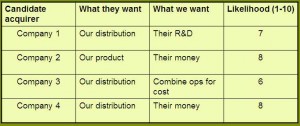 Most entrepreneurs and certainly all investors would like to see “a positive liquidity event” (a good sale of the business) someday. Boards of directors should be aware that one of their duties could be to evaluate offers from potential buyers, or even to initiate efforts to sell the business for the benefit of all stakeholders.
Most entrepreneurs and certainly all investors would like to see “a positive liquidity event” (a good sale of the business) someday. Boards of directors should be aware that one of their duties could be to evaluate offers from potential buyers, or even to initiate efforts to sell the business for the benefit of all stakeholders.
So, that’s the reason for this insight.
An exercise for you and your board
I perform the following exercise with my boards no less than once every several years in planning sessions attended by the board and senior management, sometimes augmented with an industry consultant or expert from the outside.
Here is how we do it: We use a white board or projected PC spreadsheet visible to the entire group. We draw and label four columns and ten rows. The columns: “Name of candidate buyer”, “What they want”, “What we want” and “Likelihood”.
entire group. We draw and label four columns and ten rows. The columns: “Name of candidate buyer”, “What they want”, “What we want” and “Likelihood”.
The brainstorming session
Then we begin a brainstorming session, in which we fill in the ten rows with the names of ten potential purchasers of the business, looking deeply for strategic and emotional candidates (see last week’s insight.)
The important “column two”
Once the names are filled in column one, we return to the list and use column two to have the group do its best to divine what it is about our company that would most attract the buyer if the potential buyer had perfect knowledge of our business and its resources. This could be our intellectual property, our geographic reach, our superior product, our management team, or perhaps our dominant position.
Final, quick completion of the exercise
Then I guide the group to focus upon column three, ignoring the obvious gain our company would make in liquidity (cash) to shareholders. We list what our company would most gain in new resources from this acquirer. Would it be more cash for expansion, new intellectual property, better distribution, completion of drug trials, or more? And finally, I have the group put a number in column four, estimating the likelihood of such a sale ever being consummated with that potential buyer, with “10” the absolute highest and “1” unlikely to occur.
The magic of the exercise
Not only will group focus upon the possibility of a liquidity event, it will begin to focus upon a number of possible buyers. But it is in revisiting column two of the chart that the most insight occurs. Without exception, when performing these exercises, the group quickly notes that at least four of the ten candidates, if each had perfect knowledge of our company and its resources, would want the very same thing in our firm from an acquisition. Whatever that is, it shines as the true core competency of the corporation, whether previously expressed or even recognized by management and the board.
What to do with the information
There are two near-term outcomes from the exercise. First, the board and management should see that it is in the company’s best interests to redirect resources such as manpower and money into the resulting evidence of true core competency revealed by the duplication of entries in column two (“What they want”), in order to build value more effectively and quickly than in any other area of the enterprise.
Second, it is a blueprint for the CEO to reach out and introduce himself or herself to the CEO of the target company, never discussing more that just an introduction, not to even mention a business transaction. Awareness is the principal goal. Future conversations may take a more nuanced direction, but not driven by our CEO. Let the other person, by then comfortable and more knowledgeable, make the first move. Or, if we are at that time “making the run” for a sale, then the CEO can drop the hint that the company might be “in play” or the object of another firm’s attention.
Occasionally, the insights gained from this exercise comes as a complete surprise to the board and management. And that is most rewarding to see.
